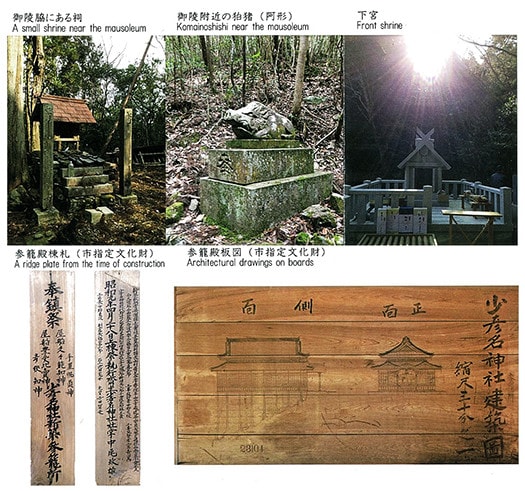


この少彦名神社とは偶然の出会いであり予備知識はなにもなく遭遇した。
で、後追いでいろいろ情報を探っています。
全国に15社、この社名の神社があるけれどほとんどが「無社格」であり、
神社本庁が認定する枠外の存在のようです。
出雲大社の本殿には現代の皇室は立ち入りできないとされるそうですが、
古代の出雲系統との「国譲り」経緯がこの少彦名神社にも関わりがありそう。
以下がその地域分類を含めた分布実態。
東北地方・青森県弘前市・青森県むつ市・秋田県大仙市・秋田県由利本荘市
中部地方・新潟県長岡市・富山県富山市・射水市・石川県珠洲市・福井県越前市
・愛知県名古屋市中区・岐阜県関市・静岡県静岡市葵区
近畿地方・大阪府大阪市中央区
中国・四国地方・岡山県津山市・愛媛県大洲市
東北日本海側北部と出雲地方は方言的な同一性が言われるし、
その交通ルートに当たる日本海側に多くが存在する。
大阪は「1780年、薬種仲買仲間の団体組織・伊勢講が薬業の繁栄を願うため、
京都の五條天神社より少彦名命の分霊を大阪道修町にあった仲間会所に勧請し、
すでに仲間会所にあった神農炎帝とともに祀ったことを起源とする」との記述。
古来からのものとは違う特定業種商売起源縁起と思われます。
名古屋や静岡については縁起が不明だけれど、
こうした大都市型・太平洋側は4社であり大多数は出雲系統と見なしうる。
伊勢神宮を中心とするヤマト朝廷側の神々とは別系統ということか。
一方、上の写真右側では「山体」そのものが少彦名命の墓神域という説明。
自然地形そのものをまるで「建築」のように見なして
神聖空間として「結界」しているように感じられる。
自然の岩や山、岬などに自然崇拝型の原初的空間信仰があったのだと思う。
出雲の人々にはそういう日本人古層の意識が強かったといえるか。
少彦名命が死んだとき「常世に向かわれた」と表現することも
いかにもこの列島古層の人間意識を感じさせてくれる。
そして梁瀬山頂上に向かって点在するスポットは個性的な空間結界をつくる。
山間らしく、阿吽像にはイノシシが表現されるなどしている。
そういった全体・山体そのものを「建築」と感じさせる。
やはり日本列島の古層の人間意識には自然崇拝基層が存在し、
建築といいう概念は単に構築物だけを指すものではないことがみえる。
建築としても、現代の再築に際し棟梁が転落死するほど、
高所へのこだわりを持った参籠殿がシンボルとされて
図示した案内パンフレット表紙にもその写真が表現されている。
この参籠殿は1934年建築とされるが、マザーになる伝承があったに違いない。
こうした高層建築は投入堂とか清水寺などが代表的だけれど
この参籠殿などは出雲大社神殿とも共通する志向性ではないか。
どうも「出雲系」の人々の気質痕跡を留めているようにも思えるのです。
そしてなぜ北海道開拓の神格として大国主命と少彦名命という
伊勢神宮系とは別の出雲系統の神々が明治初年当時、勅選されたのか。
なかなかに興味深い神社発見でした。
English version⬇
[Izumo system and nature worship type "architecture" concept Sukunahikona Shrine-4]
It was a coincidence with this Sukunahikona Shrine, and I encountered it without any prior knowledge.
So, I'm searching for various information afterwards.
There are 15 shrines nationwide with this company name, but most of them are "uncompanyed".
It seems that there is an existence outside the frame certified by the Association of Shinto Shrines.
It is said that the modern imperial family cannot enter the main shrine of Izumo Taisha.
The history of "Kuniyuzuri" with the ancient Izumo system seems to have something to do with this Sukunahikona Shrine.
The following is the actual distribution including the regional classification.
Tohoku region, Hirosaki city, Aomori prefecture, Mutsu city, Aomori prefecture, Daisen city, Akita prefecture, Yurihonjo city, Akita prefecture
Chubu region, Nagaoka city, Niigata prefecture, Toyama city, Toyama prefecture, Imizu city, Toyama prefecture, Suzu city, Ishikawa prefecture, Echizen city, Fukui prefecture
・ Naka Ward, Nagoya City, Aichi Prefecture ・ Seki City, Gifu Prefecture ・ Aoi Ward, Shizuoka City, Shizuoka Prefecture
Kinki region, Chuo Ward, Osaka City, Osaka Prefecture
Chugoku / Shikoku region / Tsuyama city, Okayama prefecture / Ozu city, Ehime prefecture
The northern part of the Tohoku Sea of Japan and the Izumo region are said to have dialectal identity.
There are many on the Sea of Japan side, which corresponds to the transportation route.
In Osaka, "In 1780, Ise-Kou, a group of drug brokers, wishes for the prosperity of the drug industry.
From Gojoten Shrine in Kyoto, we solicited the spirit of Sukunahikona Shrine to a fellow meeting place in Doshomachi, Osaka.
It originates from the fact that it was enshrined with the Shennong Flame Emperor who was already at the fellow meeting place. "
It seems to be an auspicious origin of business in a specific industry, which is different from the one from ancient times.
I don't know about Nagoya and Shizuoka, but
There are four companies on the Pacific side of such a metropolitan area, and the majority can be regarded as the Izumo system.
Is it a different system from the gods on the Yamato court side centering on Ise Jingu?
On the other hand, on the right side of the photo above, the explanation is that the "mountain body" itself is the tomb shrine of Sukunahikona.
Think of the natural terrain itself as "architecture"
It feels like a "barrier" as a sacred space.
I think there was a nature worship-type primitive spatial belief in natural rocks, mountains, and capes.
It can be said that the people of Izumo had a strong awareness of such old Japanese people.
When Sukuna bi kona died, he could describe it as "going to the everlasting world."
It really makes me feel the human consciousness of this archipelago.
And the spots scattered toward the top of Mt. Ryose create a unique spatial barrier.
Like a mountain, the statue of Aun expresses a wild boar.
The whole and the mountain body itself feels like "architecture".
After all, there is a natural worship base layer in the human consciousness of the ancient layers of the Japanese archipelago,
It seems that the concept of architecture does not simply refer to structures.
As for the architecture, the ridges fell to death during the modern reconstruction.
The symbol of Sankoden, which has a commitment to high places
The photograph is also expressed on the cover of the illustrated guide pamphlet.
This Sankoden is said to have been built in 1934, but there must have been a tradition of becoming a mother.
Typical high-rise buildings are the input hall and Kiyomizu-dera.
Isn't this Sankoden, etc. the same orientation as the Izumo Taisha Shrine?
It seems that they are keeping the traces of the temperament of the "Izumo" people.
And why are Okuninushi and Sukuna bi kona as the deities of Hokkaido development?
Did the gods of the Izumo system, which are different from the Ise Jingu system, be elected in the first year of the Meiji era?
It was a very interesting discovery of a shrine.



















